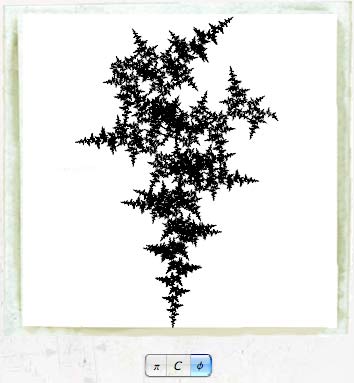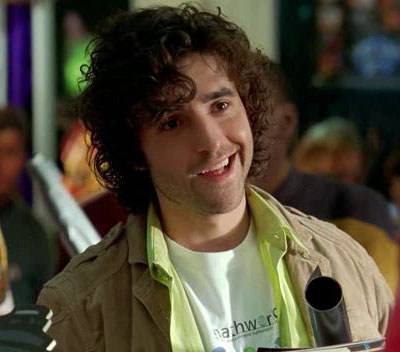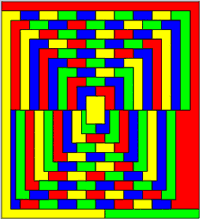



Game theory
Charlie talks to a SRO classroom. He walks around the class.
CHARLIE
People wonder how game theory can be
applied to casual relationships. With
friends, what's the strategic goal?
There's no commodity being sought, right?
But, actually even the most casual
relationship is built around a very
important commodity.
Charlie stops by a female student -- who's text messaging on
her phone. Charlie gently takes the phone. Holds it up.
CHARLIE (cont'd)
Information. When a friend shares
information, they place a value on our
intention not to use it against them. And
we are expected to share our information
with them. We can call this symmetrical
information, and it's the foundation of
partnerships between countries,
corporations, lovers, and -- friends.
Charlie turns to the board and underlines a book title:
CHARLIE (cont'd)
For next week, chapter 15 of Theory of
Games and Economic Behavior by John von
Neumann and Oskar Morgenstern.
As mentioned in last week's math notes for Episode 408, "Tabu," game theory is a branch of mathematics that deals with the analysis of games (i.e., situations involving parties with conflicting interests). In addition to the mathematical elegance and complete solution possible for simple games, the principles of game theory also find applications to complicated games, such as checkers and chess, as well as real-world problems as diverse as economics, property division, politics, and warfare.
Theory of Games and Economic Behavior is a classic text in the field of game theory, written by John von Neumann (one of the founders of game theory) and Oskar Morgenstern and first published in 1944. This book has gone through three editions, and is still used to teach game theory today. It was recently released in a new 60th-anniversary edition. Incidentally, Chapter 15 is entitled "Games with Perfect Information," and deals with combinatorial game theory (cf. Charlie's quote from Scene 4 of last week's episode, which dealt with games of imperfect information).
Besides coauthoring one of game theory's most classic texts, von Neumann proved the fundamental theorem of game theory, known as the minimax theorem, in 1928. (For more details, see last week's math notes for Episode 408.)
Circle intersections
COLBY shows Charlie the map as they walk the floor.
CHARLIE
Fourteen locations in a five-mile
radius -- excellent. I'll get you a
probable base for the seller.
The intersection of circles was considered in Episode 401 in the course of maximizing the area covered by a set of police units, each having circular coverage. For the intersection of two circles of radii R and r that are separated by a distance d (see figure at right), the area A can be given by the following slightly complicated, but beautiful formula. Here, cos-1x is the inverse function of the cosine, known (not surprisingly) as the inverse cosine function.
Symmetrically placed intersecting circles produce beautiful patterns, such as those shown below. Another example of three symmetrically placed symmetric circles is the pattern known as the Venn diagram, which, as mentioned in last week's episode, we will encounter soon in an upcoming episode.
Charlie's sartorial splendor
CHARLIE
Forgery problem, I love those. I'll
analyze the copies to see if
they're by the same person. It
would definitely help to know more
about comic books.
COLBY
You've come to the right place.
He leads Charlie up to Seth's booth. Seth's expecting them.
SETH
You're that FBI math guy, aren't
you? I read about your book.
CHARLIE
That's me. David says you're an
artist, and an expert on comic
history and collecting

Throughout the ballroom/combic book convention scene, Charlie can be seen to be wearing a very attractive MathWorld T-shirt, like the one illustrated below. (MathWorld is an online encyclopedia of mathematics created and written by NUMB3RS consultant, and author of these "Math behind NUMB3RS" pages, Eric Weisstein. Both MathWorld and the "Math Behind NUMB3RS" pages are sponsored and hosted by Wolfram Research as a free public service.) In addition to displaying the MathWorld logo, the original design of this shirt depicts three mathematical objects (the Clebsch diagonal cubic surface, a sphere packing illustrating the concept of the kissing number, and Nordstrand's weird surface) in the top row, and a monkey saddle on the bottom. You can order your own T-shirt by clicking the image below.
Fractal dimension
Seth and Charlie walk. Seth's studying a blown-up high resolution
copy of a small portion of the Ultraworld cover.
SETH
I've spent my life with comic book
art, especially Ross Moore's. I
can't tell if this is real.
CHARLIE
Because you look at the style, the
form, the drawing techniques.
SETH
Silly me. What do you do?
CHARLIE
Fractal Number Estimate. It's
based on Mandlebrot's use of
fractal dimension to measure the
jaggedness of a coastline. It's
been used to detect forged
handwriting, but we're applying it
because hand-drawn art can be
evaluated with the same process.
The class of mathematical objects known as fractals consists of objects or quantities that display self-similarity on all scales. (We have already encountered the particular fractal known as the Apollonian gasket in Episode 403.) Fractals need not exhibit exactly the same structure at all scales, but the same "type" of structures must appear on all scales. A plot of the quantity on a log-log graph versus scale gives a straight line, whose slope is said to be the fractal dimension. The prototypical example for a fractal is the length of a coastline measured with different length rulers. The shorter the ruler, the longer the length measured: a paradox known as the coastline paradox.
Fractal dimension is more commonly known to mathematicians as the capacity dimension. Analysis of fractal dimension has mostly been used for abstract art because in stylized art, the fractal dimension would depend on the amount of detail.
In addition to fractal analysis, Charlie could also use algebraic invariants from algebraic geometry. They have the advantage that they would also work for a pen curve where no ink is involved. For desirable comic books, how "artisticly" the artist is frequently matters. A true artist can plunk down the right lines perfectly, without pencils. This is very hard, and is the mark of a master.
In 1957, if an artist's pen remained stationary too long in the middle of a stroke, an ink splotch would almost certainly result. This would be something Alan could comment on, as a person who worked with blueprints, he had to do a lot of inking with inkwells. 2007 pens are much better than the 1957 pens. By carefully determining stroke counts, a different "artistly" artist, accustomed to and trained with superior equipment, would likely do a better job.
Since there are lot of perfect strokes involved in the analysis, Bézier analysis (based on the properties of Bézier curves) might work.
Mathematical proof
DON
And you can prove this?
CHARLIE
No, but I have a theory, and it's
too elegant not to be true.
A proof is a rigorous mathematical argument which unequivocally demonstrates the truth of a given proposition. A mathematical statement that has been proven is called a theorem.
According to mathematician Godfrey Harold Hardy (1877-1946):
"All physicists, and a good many quite respectable mathematicians, are contemptuous about proof. I have heard [the famous astrophysicist] Professor [Arthur Stanley] Eddington [(1882-1944)], for example, maintain that proof, as pure mathematicians understand it, is really quite uninteresting and unimportant, and that no one who is really certain that he has found something good should waste his time looking for proof.... [This opinion], with which I am sure that almost all physicists agree at the bottom of their hearts, is one to which a mathematician ought to have some reply.
A specific instance that confirms Hardy's assertion is Nobel Prize-winning physicist Richard Feynman's comment, "A great deal more is known than has been proved."

There is some debate among mathematicians as to just what constitutes a proof. The four-color theorem (which states that any map in a plane can be colored using four-colors in such a way that regions sharing a common boundary--other than a single point--do not share the same color; see figure at right for an example of a four-colored map) is an example of this debate, since its "proof" relies on exhaustive computer testing of many individual cases that cannot be verified by hand. While many mathematicians regard computer-assisted proofs as valid, some purists do not.
There are several computer systems currently under development for automated theorem proving. Mathematica itself contains a number of built-in functions for performing certain types of proofs in the theory of mathematical logic, for example, quantifier elimination using the built-in command Resolve, which in turn makes use of the powerful algebraic algorithm known as cylindrical algebraic decomposition.
Charlie's "too beautiful not to be true" quote echoes the comments of Brian Greene in his book The Elegant Universe, a guide to physics in general, and more specifically, to superstring theory. This adds an interesting new twist to the famous quote of Nobel Prize-winning physicist P. A. M. Dirac, who said, "It is more important to have beauty in one's equations than to have them fit experiment."
Auction theory
CHARLIE
The evidence will come from the
auction.
DAVID
You think that's his plan to
launder the real one -- sell it
along with all the fakes?
CHARLIE
A genuine good commingled with
false goods. In Auction Theory we
talk about equilibria or symmetry.
All bidders should have the same
exact information. But in this
case, Seth knows something the
other bidders don't know. This is
asymmetrical information. And this
can create asymmetrical bidding.
An auction is a type of sale in which members of a group of buyers offer ever increasing amounts. The bidder making the last bid (for which no higher bid is subsequently made within a specified time limit: "going once, going twice, sold") must then purchase the item in question at this price. Variants of simple bidding are also possible, as in a Vickrey auction.
References
Derbyshire, J. Prime Obsession: Bernhard Riemann and the Greatest Unsolved Problem in Mathematics. New York: Penguin, p. 291, 2004.
Greene, B. The Elegant Universe: Superstrings, Hidden Dimensions, and the Quest for the Ultimate Theory. Vintage, 1999.
Hardy, G. H. "Mathematical Proof." Mind 38, 1-25, 1929.
Hardy, G. H. Ramanujan: Twelve Lectures on Subjects Suggested by His Life and Work, 3rd ed. New York: Chelsea, pp. 15-16, 1999.
von Neumann, J. and Morgenstern, O. Theory of Games and Economic Behavior, Sixtieth-Anniversary ed.. Princeton, NJ: Princeton University Press, 2007. http://press.princeton.edu/titles/7802.html